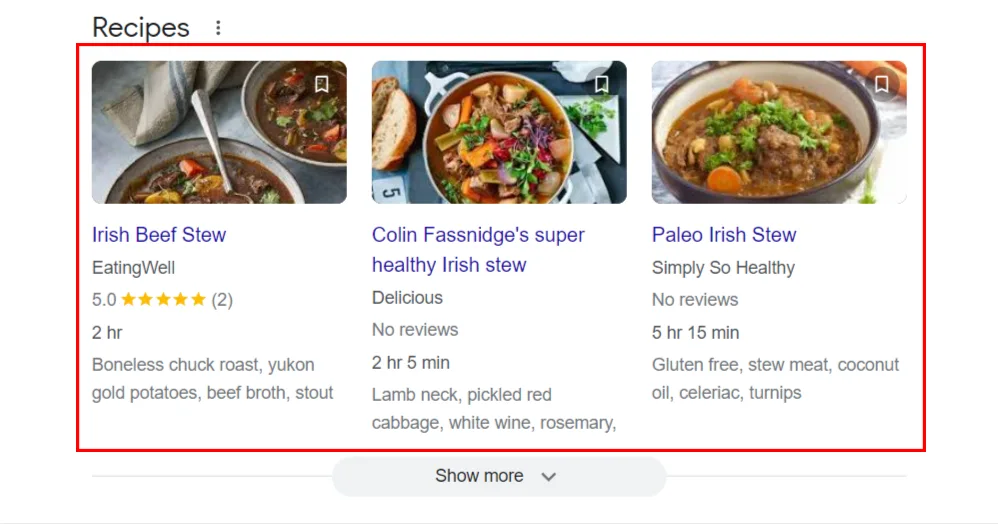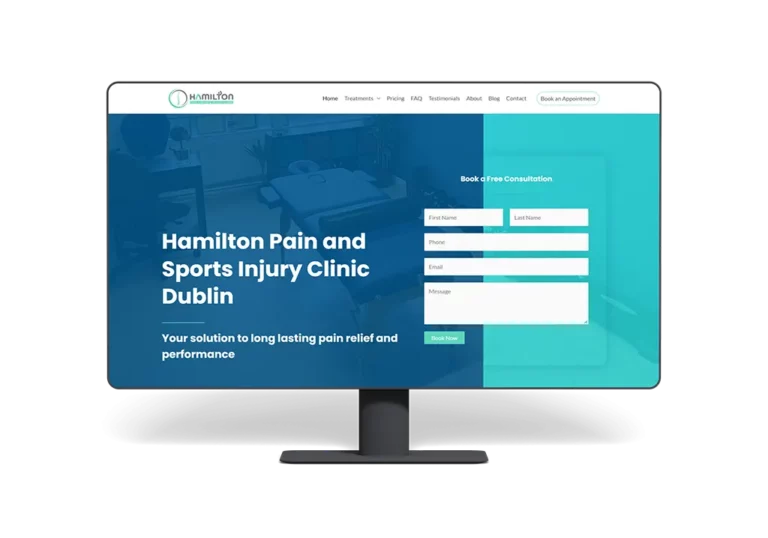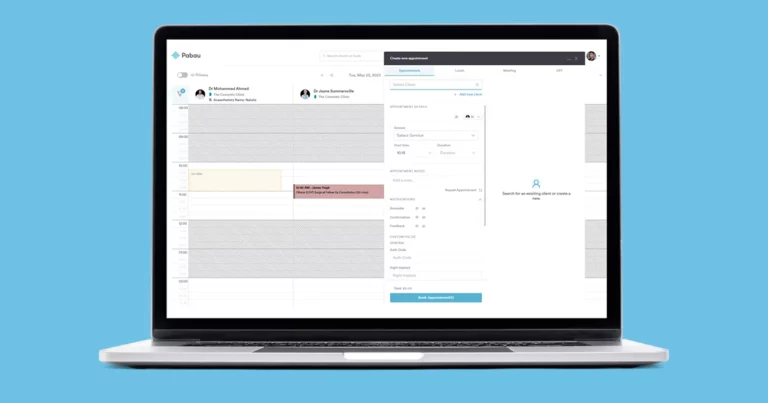What Is Local SEO?
Local SEO, or Local Search Engine Optimization, is a series of strategies used to improve your visibility in search engine results for local searches. Think of a time when you searched for something like “restaurants near me” or “dentist in Dublin.” The businesses that showed up at the top of those results didn’t get there by accident. They’ve mastered the art of local SEO. This aspect of SEO is essential for businesses with a physical location or those serving a specific geographic area.

In the context of medical clinic web design, local SEO strategies ensure that when potential patients in your area search for medical services you offer, your clinic shows up prominently in their search results.
Why Doctors Can’t Ignore SEO?
In the digital age, patients often turn to search engines for healthcare information and to find local medical clinics. As such, it’s more important than ever for doctors to ensure their online presence is robust and easily discoverable. SEO helps your website rank higher in search engine results, making it more likely potential patients will find and choose your clinic for their medical needs.
Optimizing your medical clinic web design with effective SEO strategies not only attracts more visitors to your site but also converts them into patients. In essence, SEO serves as a virtual bridge, connecting you with the people searching for the healthcare services you provide.
Creating a Powerful Google Business Profile
A key aspect of local SEO involves setting up and optimizing your Google Business Profile. This free tool by Google allows your clinic to appear in local search results and Google Maps. It’s a digital storefront, providing crucial information such as your clinic’s address, operating hours, and contact information.

A well-optimized Google Business Profile can enhance your medical clinic web design by increasing your clinic’s visibility. It can also provide valuable insights about how patients find your business and where they come from, helping you better tailor your SEO strategies.
How can you make the most out of this tool? Here are a few tips:
- Complete Your Profile: Fill in every detail that Google Business Profile provides, including your clinic’s operating hours, location, contact information, description, attributes, and services. A fully completed profile not only boosts your visibility in local search results but also fosters trust with potential patients.
- Upload Relevant Business Information: Your clinic’s name, address, phone number, website link, and operating hours are the bare minimum. Complement these basics with a comprehensive description of your clinic, spotlighting the services you offer and what sets you apart.
- Regularly Update Your Profile: Ensure your profile always mirrors current information. Be prompt in updating any changes in your hours of operation, location, or services. Regularly post updates or news about your clinic to keep your audience informed and engaged.
- Post Photos and Videos: High-quality images of your clinic’s exterior and interior, your staff, or unique medical equipment enhance your clinic’s profile. Videos offering a virtual tour or a personal message from the head doctor add a welcoming touch.
- Share Updates and Posts: Keep your audience in the loop about new services, renovations, team achievements, participation in local events, health tips, and more. Regular updates can drive engagement and keep your clinic top-of-mind.
- Detail Your Services and Products: Clearly list all the services you offer, such as general consultations, specialty treatments, and medical tests. If you sell healthcare products or offer health-related courses, include those too.
- Monitor the Q&A Section: Regularly check and respond to questions from potential patients. Encourage your loyal patients to help answer these queries and share their experiences.
- Leverage Insights: Google Business Profile provides valuable insights about how people find your clinic online and their actions on your profile. Use this data to better understand your audience and refine your SEO strategy.
- Add a Booking Button: If possible, link your booking system with your Google Business Profile. A booking button allows potential patients to conveniently schedule appointments directly from your profile.
Patient Reviews: The Virtual Word-of-Mouth
Patient reviews play a pivotal role in shaping a medical clinic’s online reputation and in influencing potential patients’ decision-making process. As a form of social proof, they provide assurance about the quality of your healthcare services. This makes them not only crucial for your credibility but also vital to your local SEO efforts and the overall effectiveness of your medical clinic web design.

Remember, it’s not just about amassing positive reviews. How you respond to all reviews, both positive and negative, makes a difference. It underscores your commitment to patient satisfaction and can enhance trust in your clinic.
Here’s a comprehensive 10-step guide to optimising your review management process:
- Encourage Reviews: Make it a routine to request patients to leave reviews post their visit. This could be through follow-up emails, text messages, or in-person requests.
- Simplify the Review Process: Ensure it’s easy for patients to leave reviews. Providing direct links to your Google Business Profile or other review platforms in your follow-up communications can significantly streamline the process.
- Acknowledge Every Review: Make sure you respond to each review. This demonstrates your appreciation of patient feedback and your commitment to improving their experience.
- Maintain Professionalism and Courtesy: Keep a professional and courteous tone when responding to reviews. Appreciate the time taken by reviewers to share their feedback, and address any negative reviews with an apology and a solution-oriented approach.
- Promote Positive Reviews: Share positive reviews on your clinic’s website or social media channels, with the patient’s permission, to enhance your online image and inspire others to share their experiences.
- Learn from Negative Reviews: View negative reviews as opportunities for improvement and address them promptly and constructively to reinforce your commitment to patient satisfaction.
- Provide Solutions: When addressing negative reviews, propose a solution to the patient’s issue. This not only resolves the immediate concern but can also turn a negative experience into a positive one.
- Advocate for Detailed Reviews: Encourage patients to share specifics about their experiences when leaving reviews. Detailed reviews provide more value to potential patients and offer deeper insights into your services.
- Stay Updated with Review Sites: Regularly monitor various review platforms to promptly catch and respond to all reviews.
- Foster a Review Culture: Inculcate a culture that values patient reviews within your clinic. Encourage your team to seek reviews and use them as learning opportunities for service improvement.
Adopting these strategies can transform patient reviews into a potent marketing tool for your clinic, thereby bolstering your online reputation and local SEO efforts. The key lies not only in gathering reviews but also in listening, responding, and evolving based on the feedback received.
Navigating Online Directories
Tapping into the power of online directories is an invaluable local SEO strategy. These directories act as online ‘yellow pages’, housing information about businesses, including medical clinics. Popular platforms like Yelp, Yellow Pages, and even specialised healthcare directories, can significantly enhance your clinic’s online visibility, making it easier for potential patients in your local area to find you.

However, simply listing your clinic in these directories isn’t enough. It’s crucial to approach this strategically to optimise the benefits.
Here are some key steps to effectively navigate online directories:
- Research Suitable Directories: Start by identifying the most suitable online directories for your medical clinic. While general platforms like Yelp and Yellow Pages are great, don’t overlook niche healthcare directories that target your specific patient base.
- Ensure NAP Consistency: When you list your clinic on these directories, pay particular attention to your Name, Address, and Phone Number (NAP). Consistency is crucial here. Any discrepancies in your NAP across different platforms can confuse search engines and potential patients, negatively impacting your local SEO performance.
- Provide Detailed Information: Beyond the NAP, provide as much relevant information about your clinic as possible. This could include your operating hours, the services you offer, pricing details, and even photos of your clinic.
- Include a Link to Your Website: Always include a link to your clinic’s website. This not only gives potential patients easy access to more information but also contributes to your backlink profile, which is beneficial for SEO.
- Encourage Patient Reviews: Many online directories allow users to leave reviews. Encourage your patients to leave reviews on these platforms to build your online reputation and enhance your credibility.
- Regularly Update Your Listing: Regularly review and update your listing to ensure the information is current and accurate. This is particularly important if there are changes to your services, operating hours, or contact information.
- Engage with Reviewers: Just as with Google Business Profile, respond to reviews on these platforms too. This demonstrates your commitment to patient satisfaction and can also provide useful feedback for your clinic.
By smartly leveraging online directories, you can boost your clinic’s online visibility, enhance your local SEO, and attract more patients to your clinic. Remember, the goal is not just to be listed but to be easily found and highly rated. For assistance in managing online directories and other aspects of medical clinic web design, don’t hesitate to contact us at Fit Bee, your trusted web design agency in Dublin.
.
Magic of Schema
Schema markup, often simply referred to as Schema, is a powerful tool in the world of SEO. Essentially, it’s a semantic vocabulary or microdata that is embedded in your website, enabling search engines to understand your content better. In return, this leads to enhanced visibility and presentation of your page in the search engine results pages (SERPs), which can significantly boost your click-through rate.

For a medical clinic’s web design, integrating schema can be a game-changer. It gives search engines more precise information about your clinic, such as your services, operating hours, locations, reviews, and more. This, in turn, can translate into rich snippets or enhanced search results that are more engaging and informative, causing your listing to stand out on the page.
Here are some useful tips on implementing schema markup effectively:
- Identify Relevant Schema Types: There are different types of schema markup. For a medical clinic, relevant types could include LocalBusiness, MedicalClinic, Physician, and more. Research and identify which types align best with your content.
- Use a Schema Markup Generator: A Schema Markup Generator can guide you through the process of creating your markup. There are many free generators available online that can simplify this process.
- Provide Detailed Information: Fill in as much relevant information as you can. The more detailed your schema markup, the better search engines can understand and present your content.
- Include Patient Reviews: If you have positive patient reviews, include them in your schema. These can appear in your rich snippets, adding a powerful element of social proof.
- Test Your Markup: Use Google’s Structured Data Testing Tool to ensure your schema markup is correctly implemented. This tool can help identify any errors or issues that may prevent your markup from working properly.
- Stay Updated: Schema.org, the consortium responsible for the Schema markup standard, regularly updates the vocabulary to adapt to the changing needs of the web. Ensure you stay updated with these changes for optimal results.
- Analyse and Improve: Over time, use analytic tools to see how your schema markup is impacting your SERPs and click-through rates. Based on this data, adjust your markup to better cater to your target audience.
Integrating schema into your medical clinic web design can appear complex, but the benefits it brings to your local SEO efforts are well worth the investment.
Inbound Links: The SEO Boost
Inbound links, often known as backlinks, are powerful tools in the SEO arsenal. They are essentially links from other websites that point back to your website. When high-authority websites, especially ones related to healthcare, link back to your site, it signals to search engines that your content is relevant and valuable. This not only boosts your credibility but also significantly amplifies your local SEO efforts. However, building a strong backlink profile can be quite the challenge, especially in a field as specialized as healthcare.

Here are some effective strategies to help you earn high-quality inbound links:
- Create Valuable Content: High-quality, informative content is the cornerstone of earning backlinks. Write blog posts or articles that provide unique insights or valuable information about healthcare topics. This increases the chances of other sites wanting to link back to your content.
- Leverage Local Partnerships: Collaborating with other local businesses or medical providers can open avenues for mutual backlinking. If you have partnerships with local labs, medical suppliers, or other healthcare providers, consider cross-promotion via backlinks.
- Guest Blogging: Contributing guest posts to reputable health blogs or online publications is a great way to earn backlinks. You’ll provide them with quality content, and in return, you can link back to your clinic’s website.
- Online Directories: Make sure your website is listed in online healthcare directories. These directories often allow you to link back to your website, providing a solid inbound link.
- Sponsor Local Events: Sponsoring local health fairs, runs, or other community events can result in backlinks from the event’s website or local news sites covering the event.
- Use Social Media: Sharing your content on social media can also lead to backlinks. When your content is shared and linked by others, it increases the chance of getting noticed by bloggers or businesses that might link to your website.
- Competitor Analysis: Use SEO tools to check which sites are linking to your competitors. You may be able to identify opportunities where you could also earn a link.
Remember, the quality of the backlinks is crucial. Links from high-authority, reputable websites are more beneficial than those from low-quality sites. It might take time and effort to build a solid backlink profile, but it’s an investment worth making for your medical clinic’s SEO health.
Content Is King: Keeping Your Patients Informed and Engaged
“Content is King” – this popular adage is a foundational truth in the world of SEO. High-quality, engaging, and informative content is a major driving force behind attracting visitors to your site and keeping them there. Be it through insightful blog posts, detailed service descriptions, or genuine patient testimonials, your website’s content should be carefully curated to cater to your patients’ needs and answer their queries.

Regularly refreshing your website with new, relevant content sends a signal to search engines that your site is active, and this can significantly influence your search rankings in a positive way. Thus, the strategic blend of SEO and high-quality content creates a potent synergy that can elevate your medical clinic web design to new heights.
Here are some practical tips to maximize the impact of your content:
- Understand Your Audience: Know your patients’ needs, preferences, and common queries. Use this understanding to guide the creation of your content.
- Provide Answers: Structure your content to answer common questions your patients might have about your services, health conditions, treatments, and more. A Frequently Asked Questions (FAQ) section can be very beneficial.
- Keep It Simple: Medical jargon can be intimidating for many patients. Ensure your content is accessible and easily understandable by using plain language.
- Update Regularly: Consistently adding fresh content keeps your site dynamic and encourages visitors to return. It also signals to search engines that your site is active.
- Optimize for SEO: Use keywords strategically and naturally throughout your content. Remember, keyword stuffing can negatively impact SEO.
- Create Varied Content: Diversify your content types – blogs, articles, infographics, videos, patient stories, etc. This keeps your site interesting and caters to different audience preferences.
- Use Multimedia: Use images, videos, and infographics to complement your text. They make your content more engaging and can explain complex health concepts more easily.
- Share Success Stories: Sharing patient testimonials and success stories build trust with potential patients. They provide real-life proof of the quality of your services.
- Promote Content: Use social media and email newsletters to share your content with a wider audience. This also encourages backlinking.
Incorporating these strategies into your content creation process can significantly improve your clinic’s online presence and visibility.
Building a Fast, User-Friendly Website
Speed and usability form the backbone of any website’s SEO performance. A fast, user-friendly website not only enhances the overall user experience but also contributes to a better ranking in search engine results. However, impediments such as slow loading times, broken links, or subpar mobile optimization can deter potential patients and negatively impact your SEO efforts. Therefore, achieving optimal performance in these areas is crucial for your medical clinic web design.

Here are some valuable tips to help you build a fast, user-friendly website:
- Minimize Loading Time: Fast loading times are crucial for maintaining user interest. Optimize your website’s speed by compressing large files, optimizing images, and reducing server response time.
- Mobile Optimization: Ensure your website is mobile-friendly. More and more people are accessing the internet via smartphones. If your site isn’t mobile-optimized, you risk losing a large chunk of potential patients.
- Easy Navigation: Organize your website intuitively, making it easy for users to find the information they need quickly. A well-structured site map aids in this process.
- Broken Links: Regularly check for and fix broken links. These can be frustrating for users and can negatively affect your SEO rankings.
- Clear Calls-to-Action (CTAs): CTAs guide your visitors to take a specific action on your website, like booking an appointment or contacting your clinic. Make your CTAs clear and prominently placed.
- Use Legible Fonts and Colors: Ensure your text is easily readable and contrasts well with the background. Also, maintain consistency in your fonts across the website for a cohesive look and feel.
- Optimize Images and Videos: High-quality visuals enhance user engagement, but they should be properly optimized. Compress images and videos to ensure they don’t slow down your page loading speed.
- Implement a Search Function: For larger sites, a search function can help users find the information they need quickly, enhancing their experience.
- Accessible Contact Information: Make it easy for users to find and contact your clinic. Prominent placement of contact information increases user trust and conversion rates.
Optimizing your medical clinic’s website for local SEO can seem daunting, but with the right strategies, it can drive more traffic to your site, increase your visibility in local search results, and ultimately lead to more patients walking through your clinic’s doors. From setting up a Google Business Profile to creating informative content and a fast, user-friendly website, each step plays a crucial role in your clinic’s online success.
At Fit Bee, we’re more than a web design agency. We’re your partners in digital growth, offering expert services in medical clinic web design and local SEO. We specialize in creating websites that are not just visually appealing but also fast, user-friendly, and optimized for mobile devices. Get in touch with us today to see how we can help your clinic thrive online.















